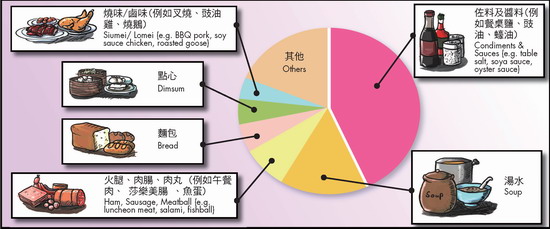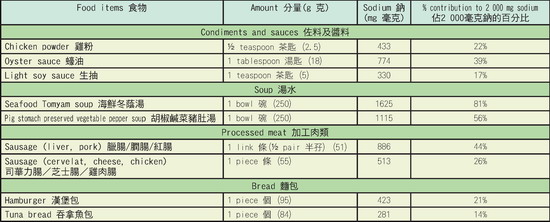
Food Safety Focus (81st Issue, April 2013) – Incident in Focus
Reduce Salt/Sodium Intake to Prevent High Blood Pressure
Reported by Dr. Violette LIN, Scientific Officer,
Risk Assessment Section,
Centre for Food Safety
The prevalence of diagnosed high blood pressure (hypertension) in Hong Kong is on the rise, from 9.3% in 2008 to 11.0% in 2011/2012. In view of this, on 2 April 2013, the Centre for Food Safety (CFS), in collaboration with the Department of Health, launched a territory-wide media and public education campaign on hypertension, especially on reducing sodium intake as one of the important preventive measures.
Relationship between Salt/Sodium Intake and Blood Pressure
An adult is said to have hypertension if blood pressure is persistently at or above 140/90 mmHg. Untreated or poorly controlled hypertension can damage the arteries and vital organs which in turn lead to coronary heart disease or stroke. The risk of developing hypertension and its complications can be reduced by reducing salt intake, eating a balanced diet, avoiding smoking and harmful use of alcohol, taking regular physical activity, etc.
Early this year, the World Health Organization (WHO) issued new guidance on sodium and potassium intake which recommends adults to consume less than 2 000 mg sodium (5 g salt) but at least 3 510 mg potassium daily from food to reduce blood pressure. As previously reported, Hong Kong people in general consume 10 g/day salt which doubles the WHO recommendation.
Major Source of Salt/Sodium Intake in the Local Diet
According to WHO, 75% of sodium in western diet is from salt in processed foods, whereas salt added during cooking and at the table is the major sodium source in traditional diets in Asia. Locally, the majority of sodium is from condiments and sauces, soup, etc. (see Figure). One needs to pay special attention in order not to exceed the WHO recommendation on dietary sodium intake (see Table).

Figure: Estimated distribution of sodium intake from local diet
Table: Sodium content of some foods high in sodium and their percentage contribution to WHO's recommendation of 2 000 mg 
(Source: Study on Sodium Content in Local Foods by the Centre for Food Safety)
Cut Sodium Intake and Ensure Sufficient Potassium Intake to Prevent Hypertension
Sodium is essential in maintaining the body's electrolyte balance but 200-500 mg/day is the estimated minimum intake needed for proper bodily function. Potassium is also essential in maintaining the body's electrolyte balance, which is commonly found in a variety of foods such as beans/peas, nuts, fresh fruits and vegetables. A diet high in processed foods and low in fresh fruits and vegetables is often high in sodium and may lead to high blood pressure. Contrarily, sufficient intake of potassium will lower blood pressure.
 Examples of potassium–rich foods
Examples of potassium–rich foods
As many Hong Kong people eat out and buy processed foods, sodium reduction therefore requires the concerted efforts of traders and consumers. Traders can refer to the Trade Guidelines for Reducing Sodium in Foods and support the activities of the CFS newly established Working Group on Reducing Sodium in Food by producing and promoting lower sodium foods. Consumers can search the Nutrient Information Inquiry System for the amount of potassium and sodium in foods. Reading nutrition label on prepackaged food can also help you choose low-sodium food.
Key Points to Note:
- WHO recommends reducing sodium intake and simultaneously increasing potassium intake to reduce the risk of high blood pressure.
- Reduce daily sodium intake to below 2 000 mg (less than one level teaspoon of salt) and ensure a daily potassium intake to above 3 510 mg.
- Consume a balanced diet with less processed foods, more fresh fruits and vegetables, and unsalted beans/peas and nuts.
Advice to Consumers
- When cooking, gradually reduce the use of salt or sodium-containing seasonings in foods to allow the taste buds get adapted to the new taste.
- When eating out, ask for less condiments/sauces and condiments/sauces to be served on the side rather than on the dishes.
- When purchasing pre-packaged foods, read the nutrition label and select lower sodium options.
Advice to the Trade
- Make reference to the Trade Guidelines to produce and promote products with lower sodium content.
- Remove condiment/sauce containers from the table and only present them to the customers when requested.
- Stepwise reduction of the use of salt and seasonings in the food supply according to the characteristics of individual food products.

